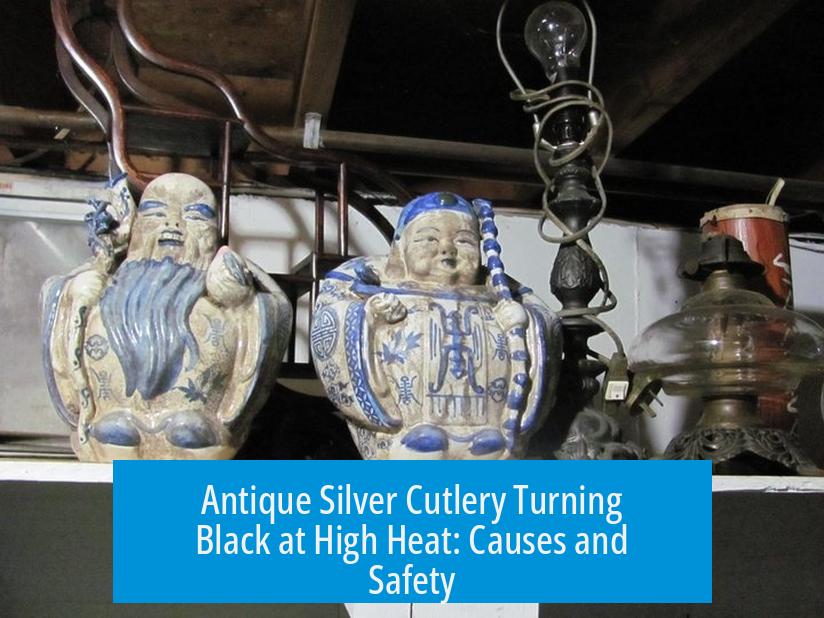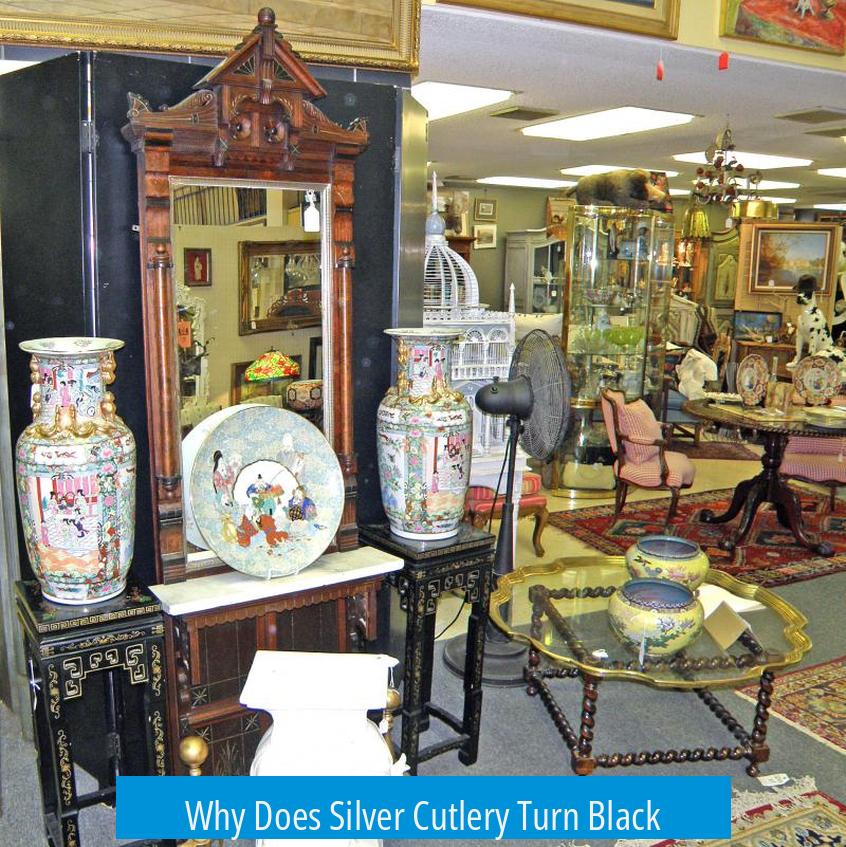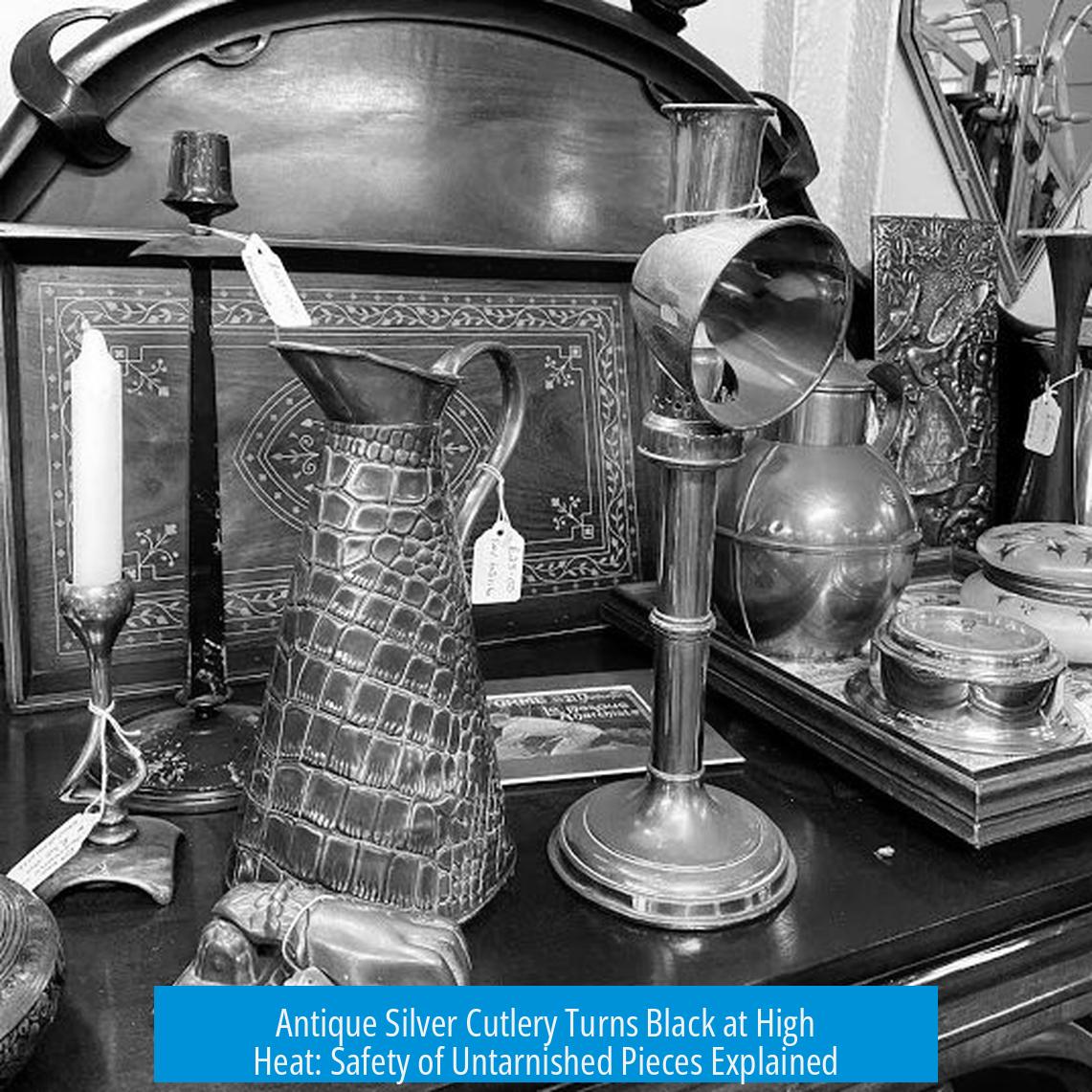Antique Silver Cutlery Turning Black at High Heat: Causes and Safety

Antique silver cutlery turns black when exposed to high heat due to surface oxidation forming silver sulfide (Ag2S). This tarnish is harmless and safe for food use once cleaned. Untarnished silver cutlery is also safe to use for eating since tarnish is only a superficial chemical change that does not pose health risks.
Why Does Silver Cutlery Turn Black?

Silver naturally tarnishes by reacting with sulfur compounds in the environment or food. This reaction forms silver sulfide (Ag2S), which appears as a black layer on the surface. The heat from cooking or exposure to hot food accelerates this chemical change.
- Black discoloration on silver is mostly silver sulfide (Ag2S), a non-toxic compound.
- Heat speeds up the oxidation but does not make the cutlery unsafe.
- Sometimes, discoloration can result from metal alloys inside the silver, such as copper.
The reaction that causes black tarnish is akin to silver reacting slowly with the sulfides found in some cooked foods, including meats like carnitas. This surface change is reversible and purely aesthetic.
Is Tarnished Silver Cutlery Safe for Eating?
Yes, silver tarnish is harmless. It is a surface chemical change and does not indicate contamination or toxicity. The tarnish itself is made of compounds like silver sulfide or silver oxide that are chemically stable and non-toxic.
- If the tarnish can be cleaned off by polishing or chemical cleaning, the cutlery is safe to use.
- Even if not removed, the tarnished surface does not pose a health risk by itself.
- The amount of silver potentially ingested from the tarnish is negligible and safe.
Untarnished silver cutlery is also safe to eat with, since tarnishing only affects the surface, not the metal’s safety. Both tarnished and untarnished antique silver satisfy safety requirements for eating utensils.
How to Clean Tarnished Silver Cutlery
Tarnish can be removed through common household methods. This reverses the black surface layer and restores the silver’s appearance.
- Aluminum Foil and Baking Soda Method: Place aluminum foil at the bottom of a bowl, add the cutlery on top, sprinkle baking soda, then add boiling water. This causes a chemical reaction that lifts tarnish off the silver.
- Silver Polishing Cloths and Liquids: Commercial silver polishers or wipes effectively remove tarnish.
- Electrochemical Cleaning: Using household items like foil and baking soda can produce an electrolysis process that cleans the silver surface.
- Hand Washing: Avoid dishwasher use and opt for gentle hand washing to prevent further oxidation.
Regular polishing maintains silver’s shine and prevents persistent corrosion. Antique silver was traditionally polished often, especially before stainless steel became widespread.
Heat Effects on Silver Cutlery
Exposure to high heat during cooking or serving accelerates tarnishing by promoting chemical reactions on the metal surface. It can also soften the metal slightly, especially at the tips, potentially making them prone to bending.
- Heat may anneal or normalize the silver, changing its mechanical properties.
- Visible discolorations such as blue or tan hues may result from heating, similar to patterns seen in heated steel but requiring high temperatures.
- Some color changes may indicate the presence of copper alloy in the silver, which also oxidizes differently.
Despite these mechanical changes, heat-induced tarnishing does not reduce safety for eating.
How to Verify Antique Silver Authenticity
Determining whether cutlery is real silver or silver-plated helps clarify its oxidation behavior and care requirements.
- Look for hallmarks on the reverse side, usually below the handle thumb rest.
- Marks indicate silver purity (e.g., “925” for sterling silver), manufacturer, or “plate” denoting silver-plated copper.
- Real silver will tarnish as described, while stainless steel or other metals may show different discoloration patterns at heat.
Reliable online resources exist for identifying silver marks, such as the Sheffield Plate article and Silver Collection Dictionary.
Are Untarnished Antique Silver Pieces Safe?
Yes. Untarnished silver is safe to use. Tarnish forms only on the surface and removal does not alter the base material. Both tarnished and untarnished silver cutlery poses no health risk when used properly.
Untarnished pieces may indicate proper storage or infrequent exposure to sulfur compounds. They are safe to eat with just the same as tarnished items.
Additional Considerations for Using Antique Silver Cutlery
- Only use silver cutlery for eating, not for cooking in direct high heat to limit tarnish development and potential softening.
- After each use, hand wash and dry silver thoroughly to prevent tarnishing.
- Be aware that copper content in silver alloys can affect tarnish color and speed.
- Annealing from heat exposure can soften tips; handle cutlery gently.
Silver cutlery requires more maintenance than stainless steel but remains popular for its aesthetic and historical appeal. Tarnish does not diminish its utility or safety.
Key Takeaways
- Black discoloration on antique silver cutlery from high heat is due to benign silver sulfide tarnish.
- Tarnished or untarnished silver is safe to eat with, as tarnish is non-toxic surface oxidation.
- Proper cleaning and polishing can restore the silver’s appearance and prevent corrosion.
- Heat accelerates tarnish and may soften silver mechanically, but does not affect food safety.
- Check silver hallmarks to verify authenticity and alloy composition for better care.
Why does antique silver cutlery turn black when exposed to heat?
Silver reacts with sulfur compounds, forming black silver sulfide tarnish. Heat speeds this process up and may cause color changes due to copper content. This discoloration is surface oxidation, not harmful.
Is tarnished silver cutlery safe to eat with?
Tarnish on silver is mostly silver sulfide, which is not toxic. Both tarnished and untarnished silver are safe for eating. Cleaning off tarnish is recommended but not required for safety.
Can I clean black tarnish from antique silver cutlery at home?
Yes. Use baking soda, aluminum foil, and boiling water to remove tarnish through electrolysis. Polishing cloths or silver polish also work well. Regular hand washing helps prevent buildup.
How do I know if my antique cutlery is real silver or plated?
Check for hallmarks or stamps on the back side of the cutlery. Marks indicate silver grade or if it is silver-plated copper. This helps confirm authenticity and material composition.
Does the black tarnish affect the durability of the silver cutlery?
Heat can anneal the silver, making the tips softer and more prone to bending. The tarnish itself does not weaken the metal but the thermal exposure may affect its strength.





Leave a Comment